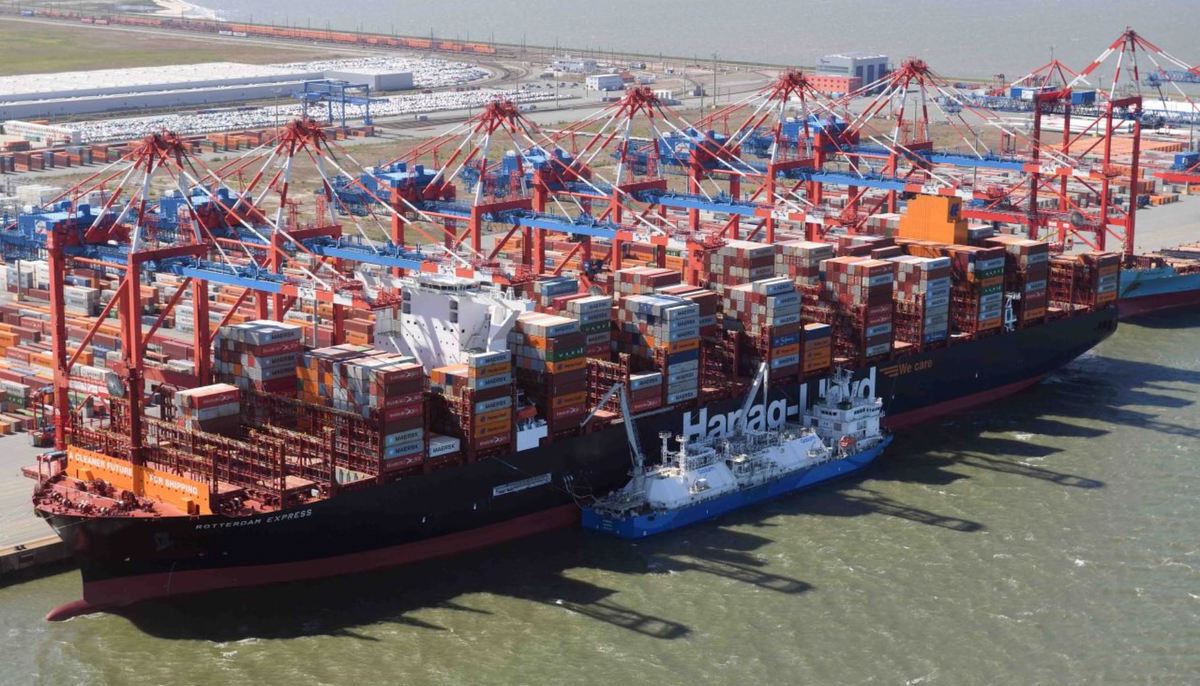UPDATE: Hapag-Lloyd starts ZEMBA-linked biomethane bunkering
Hapag-Lloyd has bunkered two of its dual-fuel vessels with a combined 4,800 mt of LBM in Europe.
 IMAGE: Gasum bunker barge supplying LBM to Hapag Lloyd containership in Wilhelmshaven. Linkedin of Gasum
IMAGE: Gasum bunker barge supplying LBM to Hapag Lloyd containership in Wilhelmshaven. Linkedin of Gasum
**This story has been updated to include comments from Hapag-Lloyd’s Nils Haupt**
German container liner Hapag-Lloyd has completed its first LBM bunker operations as part of a low-emission fuel tender issued by the Zero Emission Maritime Buyers Alliance (ZEMBA).
Hapag-Lloyd won a tender issued by ZEMBA to run replace high-emission fuels with low-emission fuels that will cut 82,000 mtCO2-equivalent (mtCO2e) emmissions between 2025-2026. Hapag-Lloyd will run vessels on liquefied biomethane (LBM) to make these emission cuts.
One of its container ships, the Rotterdam Express, recently received 3,000 mt of LBM in Wilhelmshaven, Germany. Another one, the Hanoi Express, took on 1,800 mt in Rotterdam.
Gasum was the bunker supplier for both operations, Nils Haupt, senior director corporate communications at Hapag-Lloyd told ENGINE.
“Waste based biomethane was injected into [the] European gas grid while detaching the guarantee of origins (GOs). The same GOs were then attached to recondensed LBM produced at [an] ISCC EU certified terminal. Afterwards, [the] same ISCC EU certified LBM stem was bunkered in HLAG [Hapag-Lloyd] container ships,” Haupt explained.
Both ships are part of Hapag-Lloyd’s fleet of 12 dual-fuel LNG-capable vessels, several of which will be gradually added to the ZEMBA partnership this year.
The shipping firm will then allocate carbon credits to ZEMBA members based on the greenhouse gas (GHG) reductions it achieves from its LBM-fuelled voyages between Europe and Asia. A book-and-claim mechanism will be used to redistribute these carbon credits.
This system allows major cargo owners to claim Scope 3 emission savings by paying premiums for carbon credits to Hapag-Lloyd and other shipping companies, even if their actual cargo is transported on conventionally-fuelled vessels.
ZEMBA members include Amazon, Nike, Meta, Patagonia and several other global retailers. The alliance has set a collective target to abate at least 82,000 mtCO2e during 2025–2026 by running Hapag-Lloyd vessels on waste-based LBM.
“The GHG reductions are expressed in WTW [well-to-wake] figures,” Haupt said.
This means “we combine the values from the Grid injection/bunkering on board = WTT [well-to-tank] and add the onboard combustion values (TTW [tank-to-wake]) to come to a complete WTW figure as per ZEMBA requirements,” he added.
LBM can deliver up to 95% lower GHG emissions than conventional marine fuels like LSMGO, according to Gasum.
“Throughout 2025 and 2026, Hapag-Lloyd will help ZEMBA members achieve over 90% GHG emission reductions on their committed volumes compared to high-emission fuel services using entirely waste-based biomethane,” ZEMBA said in a post.
By Konica Bhatt
Please get in touch with comments or additional info to news@engine.online





